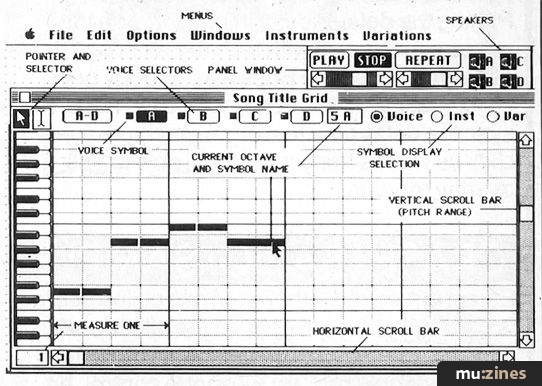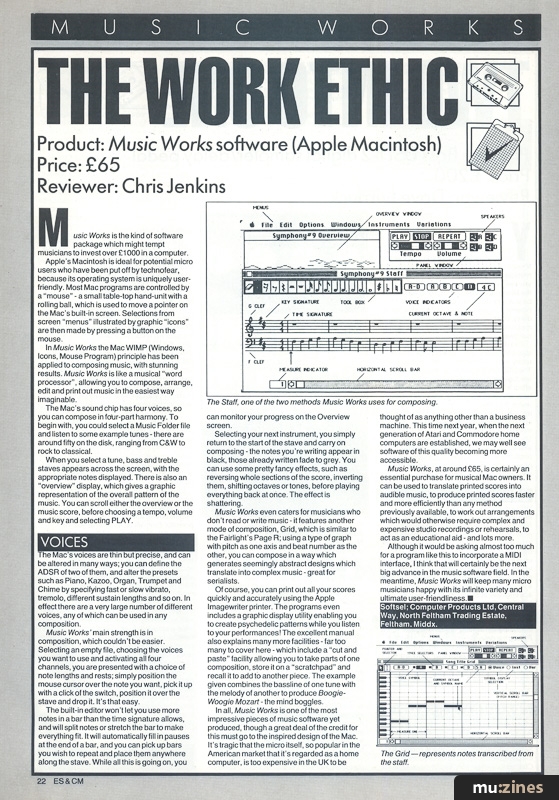Magazine Archive
Home -> Magazines -> Issues -> Articles in this issue -> View
The Work Ethic | |
Music Works software (Apple Macintosh)Article from Electronic Soundmaker & Computer Music, August 1985 | |
Music software for the Macintosh

The Staff, one of the two methods Music Works uses for composing.
Music Works is the kind of software package which might tempt musicians to invest over £1000 in a computer.
Apple's Macintosh is ideal for potential micro users who have been put off by technofear, because its operating system is uniquely user-friendly. Most Mac programs are controlled by a "mouse" - a small table-top hand-unit with a rolling ball, which is used to move a pointer on the Mac's built-in screen. Selections from screen "menus" illustrated by graphic "icons" are then made by pressing a button on the mouse.
In Music Works the Mac WIMP (Windows, Icons, Mouse Program) principle has been applied to composing music, with stunning results. Music Works is like a musical "word processor", allowing you to compose, arrange, edit and print out music in the easiest way imaginable.
The Mac's sound chip has four voices, so you can compose in four-part harmony. To begin with, you could select a Music Folder file and listen to some example tunes - there are around fifty on the disk, ranging from C&W to rock to classical.
When you select a tune, bass and treble staves appears across the screen, with the appropriate notes displayed. There is also an "overview" display, which gives a graphic representation of the overall pattern of the music. You can scroll either the overview or the music score, before choosing a tempo, volume and key and selecting PLAY.
VOICES
The Mac's voices are thin but precise, and can be altered in many ways; you can define the ADSR of two of them, and alter the presets such as Piano, Kazoo, Organ, Trumpet and Chime by specifying fast or slow vibrato, tremolo, different sustain lengths and so on. In effect there are a very large number of different voices, any of which can be used in any composition.
Music Works' main strength is in composition, which couldn't be easier. Selecting an empty file, choosing the voices you want to use and activating all four channels, you are presented with a choice of note lengths and rests; simply position the mouse cursor over the note you want, pick it up with a click of the switch, position it over the stave and drop it. It's that easy.
The built-in editor won't let you use more notes in a bar than the time signature allows, and will split notes or stretch the bar to make everything fit. It will automatically fill in pauses at the end of a bar, and you can pickup bars you wish to repeat and place them anywhere along the stave. While all this is going on, you can monitor your progress on the Overview screen.
Selecting your next instrument, you simply return to the start of the stave and carry on composing - the notes you're writing appear in black, those already written fade to grey. You can use some pretty fancy effects, such as reversing whole sections of the score, inverting them, shifting octaves or tones, before playing everything back at once. The effect is shattering.

The Grid — represents notes transcribed from the staff.
Music Works even caters for musicians who don't read or write music - it features another mode of composition, Grid, which is similar to the Fairlight's Page R; using a type of graph with pitch as one axis and beat number as the other, you can compose in a way which generates seemingly abstract designs which translate into complex music - great for serialists.
Of course, you can print out all your scores quickly and accurately using the Apple Imagewriter printer. The programs even includes a graphic display utility enabling you to create psychedelic patterns while you listen to your performances! The excellent manual also explains many more facilities - far too many to cover here - which include a "cut and paste" facility allowing you to take parts of one composition, store it on a "scratchpad" and recall it to add to another piece. The example given combines the bassline of one tune with the melody of another to produce Boogie-Woogie Mozart - the mind boggles.
In all, Music Works is one of the most impressive pieces of music software yet produced, though a great deal of the credit for this must go to the inspired design of the Mac. It's tragic that the micro itself, so popular in the American market that it's regarded as a home computer, is too expensive in the UK to be thought of as anything other than a business machine. This time next year, when the next generation of Atari and Commodore home computers are established, we may well see software of this quality becoming more accessible.
Music Works, at around £65, is certainly an essential purchase for musical Mac owners. It can be used to translate printed scores into audible music, to produce printed scores faster and more efficiently than any method previously available, to work out arrangements which would otherwise require complex and expensive studio recordings or rehearsals, to act as an educational aid - and lots more.
Although it would be asking almost too much for a program like this to incorporate a MIDI interface, I think that will certainly be the next big advance in the music software field. In the meantime, Music Works will keep many micro musicians happy with its infinite variety and ultimate user-friendliness.
Softsel; (Contact Details).
Publisher: Electronic Soundmaker & Computer Music - Cover Publications Ltd, Northern & Shell Ltd.
The current copyright owner/s of this content may differ from the originally published copyright notice.
More details on copyright ownership...
Review by Chris Jenkins
Help Support The Things You Love
mu:zines is the result of thousands of hours of effort, and will require many thousands more going forward to reach our goals of getting all this content online.
If you value this resource, you can support this project - it really helps!
Donations for November 2025
Issues donated this month: 0
New issues that have been donated or scanned for us this month.
Funds donated this month: £0.00
All donations and support are gratefully appreciated - thank you.
Magazines Needed - Can You Help?
Do you have any of these magazine issues?
If so, and you can donate, lend or scan them to help complete our archive, please get in touch via the Contribute page - thanks!




